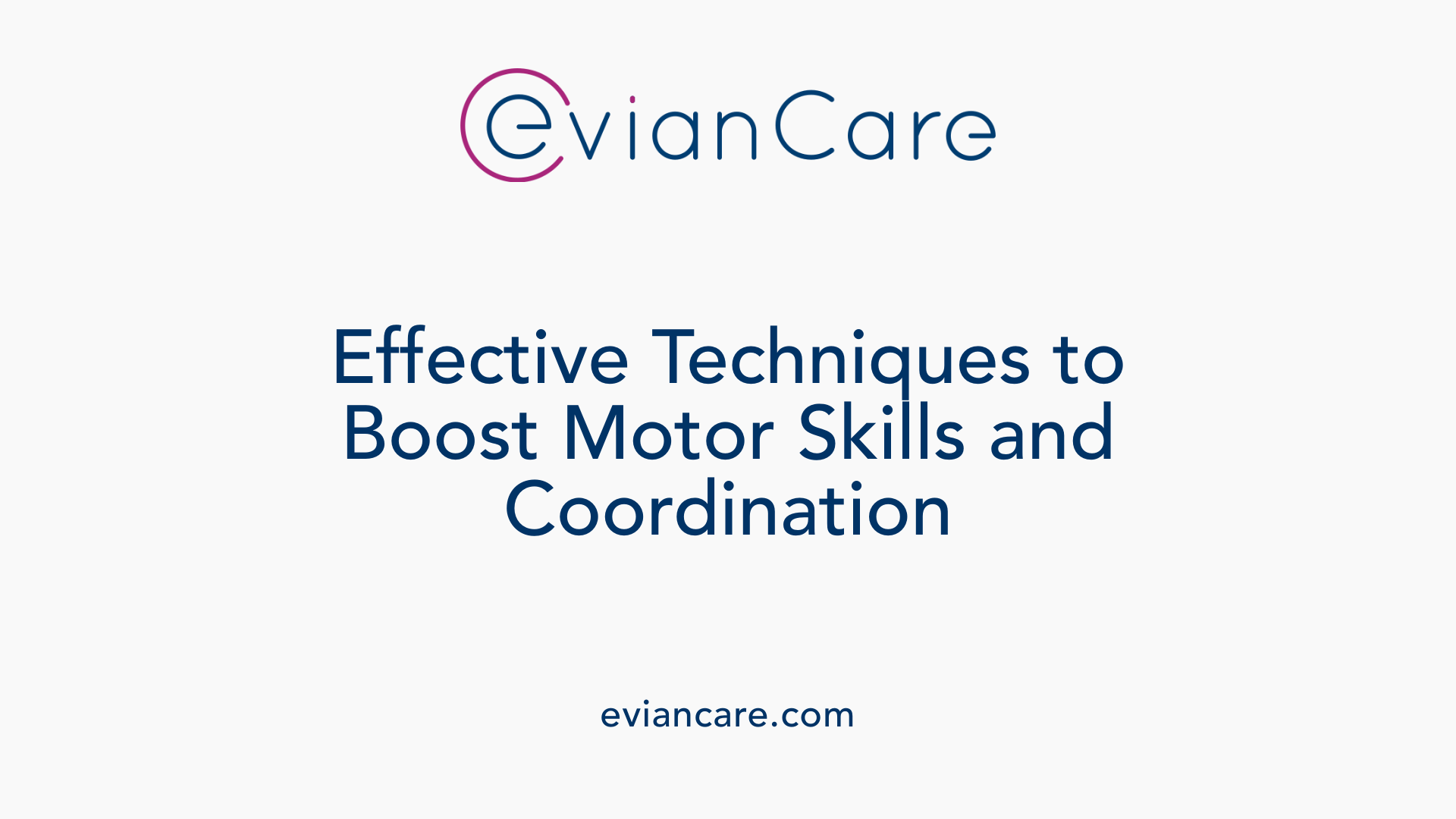
Understanding the Critical Role of Physiotherapy in Developmental Support
Children with Down syndrome often experience delays and challenges in motor development due to factors like hypotonia, joint laxity, and impaired muscle tone. Physical therapy plays a vital role in improving their coordination, balance, and overall mobility. This article explores how tailored physiotherapy interventions can support these children in achieving developmental milestones, enhancing their independence, participation in daily activities, and quality of life.
Personalizing Treatment Plans for Optimal Motor Development

How can caregivers and therapists tailor treatment plans to support motor development in children with Down syndrome?
Supportive and effective motor development strategies require a personalized approach that considers each child's individual strengths and challenges. Caregivers and therapists should work closely to create customized treatment plans that align with the child's unique needs, developmental stage, and interests.
One effective method is the use of visual supports, such as pictures, symbols, and visual schedules, which can help children understand tasks and stay motivated. Breaking complex motor skills into smaller, achievable steps allows children to build confidence and master each component gradually. For example, a child learning to walk might first practice standing independently, then stepping with support, and finally walking unaided.
Establishing consistent routines and creating predictable environments contribute to a child's sense of security, which promotes participation and reduces anxiety during motor activities. Routine activities, such as daily stretching or balance exercises, can become familiar rituals that reinforce learning.
In addition, multisensory approaches—combining tactile, auditory, and visual stimuli—can enhance motor learning. Activities like textured toys for tactile feedback, music to motivate movement, and visual cues for timing and sequencing engage multiple senses, improving coordination and motor planning.
Ongoing collaboration among caregivers, educators, and health professionals ensures that interventions remain relevant and adaptable. Regular assessment and feedback help identify areas of progress and challenges, allowing for timely modifications to the treatment plan. Tailoring interventions in this way maximizes the child's potential, promotes independence, and supports successful participation in everyday activities.
The Significance of Physical Therapy in Enhancing Coordination

What is the role of physical therapy in improving coordination for children with Down syndrome?
Physical therapy is crucial in helping children with Down syndrome improve their coordination, which can be affected by factors such as hypotonia (low muscle tone), joint laxity, and impaired motor control. Early intervention is especially important and typically begins in infancy, focusing on strengthening core muscles — the muscles around the trunk and neck — to support stable movement.
Therapists design personalized programs that include strength training, balance exercises, and sensory-motor integration activities. A play-based and functional approach makes therapy engaging, motivating children to participate actively. For example, therapists might encourage children to reach for toys, sit or stand on unsteady surfaces, or move through obstacle courses. These activities challenge and develop the child's movement reactions, coordination, and balance.
Supporting motor skills development begins with foundational milestones like sitting, crawling, and standing. As children grow, therapy enhances their ability to perform more complex tasks such as walking, running, and jumping. Using adaptive tools and techniques helps children gain independence in daily activities, boosting their confidence.
In addition to physical strength and balance, therapy also targets posture correction. Proper alignment is vital for efficient movement and preventing long-term musculoskeletal issues. Regular practice of dynamic activities like climbing stairs or walking on uneven surfaces promotes better motor planning and coordination.
Overall, physical therapy plays a vital role in fostering functional motor skills, increasing independence, and enabling children with Down syndrome to participate fully in social and recreational activities. By improving core stability, balance, and movement control, therapy helps children meet developmental milestones and build a foundation for lifelong physical activity.
Exercise Modalities and Activities for Motor Skill Enhancement

What types of exercises and activity-based interventions are recommended for improving coordination in children with Down syndrome?
Physical therapists suggest a broad range of exercises and activities to help children with Down syndrome improve their coordination skills. These interventions aim to strengthen muscles, enhance balance, and refine motor control, which are often impacted by hypotonia and joint laxity common in this population.
Early physical therapy is vital in establishing correct movement patterns and promoting muscle strength. For infants and toddlers, activities like tummy time, reaching for toys, and sitting or standing on unstable surfaces serve to develop foundational gross motor skills.
As children grow, tailored exercises focus on specific milestones such as crawling, standing, walking, and running. These activities are designed to be engaging and age-appropriate, often incorporating play to motivate participation.
Balance exercises, like standing on one foot, walking on lines, or balancing on different surfaces, help improve postural stability. Coordination drills may include climbing stairs, hopping, skipping, or using obstacle courses to challenge and develop motor agility.
In addition, play-based activities such as hopping games, catching and throwing balls, and dance-based routines further enhance motor skills, making the therapy process enjoyable and encouraging consistent practice.
For adolescents and adults, exercises become more advanced, emphasizing functional movement patterns that support independence in daily activities. Specific drills might include dynamic balance exercises, resistance band workouts, and activities that require limb coordination, such as cycling or swimming.
Therapists craft individualized treatment plans that focus on the child's strengths and challenges, incorporating progressive difficulty levels to promote continuous development. The use of specialized equipment like balance beams, trampolines, and sensory integration tools also complements exercise programs.
Overall, these targeted interventions are designed to optimize physical capabilities, foster confidence, and enable participation in a wide range of physical activities, ultimately supporting social inclusion and quality of life.
Therapeutic Techniques and Interventions for Enhancing Motor Skills

What therapeutic techniques are used to enhance motor skills and coordination in children with Down syndrome?
Children with Down syndrome often face delays and difficulties in motor skills and coordination, resulting from factors like hypotonia (low muscle tone), joint laxity, and muscular weakness. To help overcome these challenges, a combination of therapeutic approaches is employed.
Physical therapy (PT) is central to this effort. It uses exercises to strengthen muscles, improve overall body posture, and develop stability. Activities like resistance training, balance tasks, obstacle courses, and sensory-motor integration exercises are designed to support gross motor development, such as sitting, crawling, standing, and walking.
Occupational therapy (OT) complements PT by focusing on fine motor skills—like grasping, manipulating objects, self-care tasks, and dressing—that boost independence in daily routines.
Speech and language therapy, although primarily aimed at communication, also involves motor control of the oral and facial muscles important for speech and eating.
Beyond these, specific activities and strategies include:
- Strength training with resistance bands
- Balance exercises on unstable surfaces
- Sensory integration activities like swinging or tactile play
- Gait training and functional movement practice
These interventions are tailored to each child's development stage and abilities, with early initiation showing better outcomes. A collaborative approach involving parents, caregivers, and healthcare providers ensures therapy is consistent and effective.
What developmental challenges related to motor skills and coordination do children with Down syndrome face, and how can physiotherapy address these?
Children with Down syndrome often experience delays in motor milestone achievements such as sitting independently, crawling, and walking, primarily due to hypotonia and joint laxity.
These physical characteristics lead to poor muscle strength, imbalances in muscle tone, and difficulties with balance and coordination. Consequently, children are at higher risk for falls and may develop gait abnormalities.
Physiotherapy offers targeted interventions to address these issues early. Starting before the age of one, physiotherapists implement activities focused on building strength in neck, trunk, and limb muscles. Exercises like weight-bearing activities, controlled stretching, and postural control tasks help improve muscle tone.
Balance training involves activities that challenge a child's stability, such as sitting on unsteady surfaces or reaching for objects while maintaining posture. Sensory-motor integration exercises enhance coordination and body awareness.
Functional training, including activities that mimic real-life tasks like standing from a sitting position, stepping up stairs, or crawling through obstacle courses, encourages motor milestone achievements.
Early, consistent physiotherapy strengthens the musculoskeletal system, improves motor control, and provides children with the stability needed for independent movement. This comprehensive approach promotes greater mobility, confidence, and participation in daily activities, laying a solid foundation for future development.
The Evidence Supporting Physical Therapy for Coordination Improvement
Research studies and meta-analyses consistently demonstrate that physical therapy is highly effective in improving coordination among children with Down syndrome.
A comprehensive review of eight randomized controlled trials involving 260 participants revealed significant positive effects of physical exercise on balance. The reported standardized mean difference (SMD) was 1.28 for overall balance and 1.45 for dynamic balance, with p-values less than 0.0001, indicating strong statistical significance.
Specific interventions such as treadmill training, core stability exercises, Pilates, swimming, cycling, trampoline activities, hippotherapy, and whole-body vibration training show promising results. For example, treadmill and core stability exercises have been identified as particularly effective in enhancing both static and dynamic balance.
In addition, targeted physiotherapy techniques like strengthening exercises—such as resistance band training, obstacle courses, and balance activities—improve muscle strength, coordination, and postural stability. Sensory integration activities, combined with physiotherapy, have also contributed to improvements in posture, motor control, and grip strength.
A notable study in the Journal of Pediatric Rehabilitation Medicine found that physiotherapy methodologies not only significantly improved gross motor skills, such as walking and jumping, but also boosted confidence, social participation, and sensory processing.
Long-term benefits include sustained gains in mobility, better postural control, and increased independence, which positively influence overall quality of life. Continual motor skill development through personalized physiotherapy contributes to improved physical fitness and functional participation.
In summary, the evidence from diverse research sources underscores that structured, activity-based physical therapy effectively enhances strength, balance, and coordination—crucial factors for mobility and daily functioning—serving as an essential intervention in the management of Down syndrome.
Lifelong Physical Activity and Its Role in Maintaining Skills
How can caregivers and therapists tailor treatment plans to support motor development in children with Down syndrome?
Supporting motor development in children with Down syndrome requires personalized approaches that cater to each child's unique needs. Caregivers and therapists collaborate closely to create individualized plans that target specific strengths and challenges of the child. Visual supports, such as pictures, symbols, and step-by-step instructions, help children understand and anticipate activities better, promoting active participation.
Breaking down complex motor tasks into smaller, manageable steps makes the learning process less overwhelming and builds confidence. For example, teaching a child to climb stairs might start with practicing stepping onto a low platform before progressing to stairs.
Establishing consistent routines and a predictable environment fosters a sense of security, making children more willing to engage in motor activities. Incorporating multisensory learning—using tactile, auditory, and visual stimuli—can reinforce skill acquisition, improve coordination, and stimulate neural pathways.
Ongoing collaboration with a team of healthcare providers, educators, and family members ensures that interventions stay aligned with the child's growth. Monitoring progress and modifying strategies as needed helps keep development on track.
Such tailored, engaging, and supportive plans are crucial from infancy through adulthood, helping individuals with Down syndrome achieve their full potential in motor skills and overall physical health.
Balancing Early Intervention with Continued Growth and Development
What is the role of physical therapy in improving coordination for children with Down syndrome?
Physical therapy is crucial in supporting children with Down syndrome to improve their coordination, which is often affected by low muscle tone (hypotonia) and joint laxity. Early intervention by pediatric physical therapists focuses on strengthening core muscles, enhancing posture, and developing essential motor skills through engaging and playful activities.
Therapists utilize various techniques such as encouraging movement on uneven or unstable surfaces, promoting reaching for objects, and practicing transitions from sitting to standing. Using adaptive equipment like balance beams, therapy balls, and trampolines can also significantly support motor skill development.
This approach helps children meet vital developmental milestones, including sitting steadily, crawling, and walking independently. Improved coordination boosts their confidence and participation in daily routines, fostering a greater sense of autonomy.
Continued physical therapy as children grow ensures ongoing support for developing new skills like running, jumping, and balance activities. These efforts enhance overall physical ability, promote social interaction, and help children with Down syndrome reach their full motor potential.
Conclusion: Embracing a Holistic Approach to Support Development
A comprehensive approach to supporting children and individuals with Down syndrome involves collaboration across various healthcare disciplines, including physical therapists, occupational therapists, speech-language pathologists, and educators. These professionals work together to create personalized strategies that target motor skills, sensory processing, communication, and daily living activities.
Continued engagement in physical activity is vital throughout life. Regular exercises such as swimming, dancing, balance training, and sport participation help maintain strength, balance, and cardiovascular health. Early intervention, especially in infancy, sets a strong foundation for motor development, but ongoing therapy and adaptive exercises are crucial for lifelong well-being.
Interventions should be tailored to each person's unique needs, abilities, and goals. This personalized approach enhances motivation, progression, and outcomes. Whether focusing on improving walking, strengthening muscles, or developing fine motor skills, customized strategies ensure the most effective support.
Ultimately, an integrated, lifelong plan promotes independence and enhances quality of life. Through consistent physical activity, supportive therapies, and adaptive techniques, individuals with Down syndrome can achieve their fullest potential, thriving socially, physically, and emotionally.
Fostering Growth and Independence Through Tailored Therapeutic Strategies
Supporting children with Down syndrome in achieving their full potential requires a comprehensive, individualized approach that integrates early intervention, ongoing therapy, and active participation in physical activities. Physical therapy, complemented by occupational and speech therapies, addresses both motor and communication challenges. Evidence-based methods such as strength training, balance exercises, sensory integration, and functional activities have demonstrated significant benefits, including improved coordination, strength, and independence. Collaboration between therapists, caregivers, educators, and healthcare professionals ensures that intervention plans adapt to the child's evolving needs. Promoting life-long physical activity, from infancy through adulthood, supports optimal growth, health, and well-being. Ultimately, a holistic, multidisciplinary approach fosters confidence, social inclusion, and a better quality of life for children with Down syndrome.
References
- Physical Therapy, Occupational Therapy, Speech, & Down Syndrome
- Effects of early physical therapy on motor development in children ...
- Effects of physical exercises on balance in children with down ...
- 3 Ways Physical Therapists Help People with Down Syndrome
- Improving Balance in Children with Down Syndrome
- Is Physical Therapy for Down Syndrome Effective for All Ages?
- Down syndrome Therapy Ideas, Exercises and Activities
- Why Physical Therapy is a Game-Changer for Kids with Down ...
- Physical Therapy for Child With Down Syndrome
- Pediatric PT for Down Syndrome - Number Analytics












